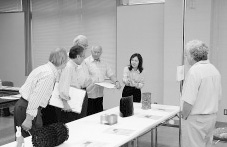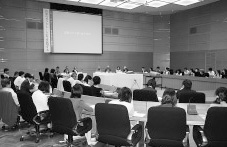Audience2 As one of the staff members I have seen you performing the Final Assessment. I’ve learned a lot of from how all the jurors discussed and decided the prize winners. Thank you.
The title of today’s symposium is “What’s Going on in the World of Glass Art”. Mr. Christensen mentioned in his comments that as one of the new trends in the world of glass art, glass artworks tend to be simpler in form. This time many of the prize winners are calm or communicating with the viewers or have something oriental and philosophical or having to do with Chinese philosophy or Indian Yoga. I’d like to know more in detail about the new trends and what’s going on in the world of glass art other than those prize winners.
Takeda The question is about what’s going on in the world of glass art, just the same as the theme and title of this symposium. I’d like all the jurors to answer this question. Please tell us about the present situation and new trends.
Harcuva Glass is in the same as any other field of art, the same as in architecture, painting, sculpture, glass is a part of it. So I think that it cannot be devided, glass into functional and not functional. Maybe there’re special competitions for design and as I know in the glass world today it’s more about free forms and the design is more regulated in architecture, interior architecture. So I don’t know maybe in the future it will rejoin somehow together.
Takeda Next, Mr. Christensen and Mr. Myers, please.
 Christensen You’ve absolutely right. Modern glass art is a part of the total scene of art today. But it’s also something which adds to modern art in a specific way. It has shown in the last thirty to forty years, glass has been for many artists a very important material to express themselves. That is something you can see in other period that some kinds of materials and techniques and so on and the ideas developed in specific part of the art world. And no doubt about it, glass has been very important part of modern art up until now. Such thing will change, no doubt about it. The complexity of glass art today because so many are involved, so many concerns are in a caustic thing, but it will also in the very end in a confusing manner which can end up someday or chance to focus to other materials and other way of expressing yourself. But in the moment, glass definitely are very important in the art world.
Christensen You’ve absolutely right. Modern glass art is a part of the total scene of art today. But it’s also something which adds to modern art in a specific way. It has shown in the last thirty to forty years, glass has been for many artists a very important material to express themselves. That is something you can see in other period that some kinds of materials and techniques and so on and the ideas developed in specific part of the art world. And no doubt about it, glass has been very important part of modern art up until now. Such thing will change, no doubt about it. The complexity of glass art today because so many are involved, so many concerns are in a caustic thing, but it will also in the very end in a confusing manner which can end up someday or chance to focus to other materials and other way of expressing yourself. But in the moment, glass definitely are very important in the art world.
Myers I’d like to ask some of you what you think is missing. But I won’t, because I’ll tell you part of what’s missing is because of the limitations that have been set up by the Executive Committee for practical reasons. What’s missing here are installation art and conceptual art. Those examples are what’s happening in the glass world particularly. It’s been happening for a long time and larger art work, but that’s the great deal of what’s happening even if for that matter performance art these things require different set of circumstances to have such a competition. But they are the fates that we actually missing. When you visit the exhibition and look at the exhibition works, you will see what’s happening in the glass art world.
Takeda Next, Mr. Yokoyama, please.
Yokoyama This exhibition of this year just shows what’ going on in the world of glass art. When you look at each work, you should feel yourself what’s going on. Unlike information on glass art and artworks on magazines and journals, you can grasp something by actually looking at the exhibited pieces.
For this, the International Exhibition of Glass Kanazawa is an significant event.
Takeda Your question is very important. Are you satisfied with the answers from all the jurors?
I, myself, looked at the National Festival in Starbridge, UK last year and another exhibition in Australia with young artists two years ago. My impression on both exhibitions is that they had similar contents. The level of the exhibition in Australia was much higher than before. The impression on the exhibition is completely different from that of the exhibition in the past. As all the jurors pointed out, the level of glass art in Japan has been higher and higher, perhaps because the art education system has truly been promoted. Young artist who were well educated in advanced art schools and institutes have been self-developed and have worked out their individual pieces. As a result, as a whole, the level of glass art has been higher throughout the world.
Each artist works on each individual pieces, so each artist works differently. So what’s been new trends ? Contemporary arts including fine art and glass art have been diversified. Sometimes a pioneer type of artist starts something new and makes a new trend but others do something else. It is impossible to grasp a particular new trend in glass. You don’t have to care so much about the new trends. As Mr. Yokoyama mentioned, this exhibition itself is a showcase of new trends of the world of glass art, but this cannot necessarily show all the new trends. It’s as if only a cross section of the whole.
Another question?
Audience3 Looking at the Grand Prize winner, I was fascinated with it. The piece has made me feel like going to the piece and touching its surface. I’d like to know how the surface was finished.
Takeda Does anyone want to answer this question? Mr. Christensen mentioned a little about hammering or something?
Christensen Once I have interviewed the artist so I have to see my note that I have taken. But I can say that along way with start off to form in clay and then she used very complicated processes. She was educated in sculpture, so she is familiar of having crafts ability to work on the sculpture in stone. So she had, so to say, a hammer to give the sculpture surface of the glass.
You’re right. It is for her very important that you also have tactile feeling that also, so to say, be able to feel her sculpture when you put your hand on it. It is so visual that you should have a feeling how you would like to touch it. That’s a part of the way she expresses herself in glass.
Takeda Thank you. Another question? If you don’t have any other questions, I’d like to bring the symposium to close because its getting late. Thank you so much for having me as a modulator and for listening to us.
Closing
 Boda(MC) Thank you very much. I’m afraid we are running out of time. I hope that you will come to see the exhibition held at Korimbo Daiwa from August 26, 2004 on.
Boda(MC) Thank you very much. I’m afraid we are running out of time. I hope that you will come to see the exhibition held at Korimbo Daiwa from August 26, 2004 on.
This exhibition in Kanazawa will last for a week. Then it will move to the Notojima Glass Art Museum and the exhibition there will start on October 2, 2004. The two venues are completely different, so we look forward to both exhibitions.
Together with this exhibition in Kanazawa, glass artworks by young glass artists of Toyama, Ishikawa, and Fukui will be exhibited and sold. We hope this will be a step forward for you to enjoy more glassware in your everyday lives. The theme for this plan is “Tableware for Everyday Use to Artworks Available and Reasonable”.
We would like to bring the Round Table Discussion for the International Exhibition of Glass Kanazawa 2007 to close. Please give all the jurors another round of applause. Thank you very much.
For all the participants today, thank you for coming.

